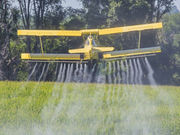One toxin in particular was tied to six-fold higher odds of developing ALS
TUESDAY, May 10, 2016 (HealthDay News) — Exposure to pesticides and other chemicals may increase the risk for amyotrophic lateral sclerosis (ALS), according to a study published online May 9 in JAMA Neurology.
Stephen Goutman, M.D., assistant professor of neurology at the University of Michigan and director of its ALS Clinic in Ann Arbor, and colleagues evaluated 156 patients with ALS and 128 without the disease. Participants were asked about occupational and residential exposure to environmental toxins. Blood samples were taken to measure pesticide levels. The researchers looked at 122 environmental chemicals and pesticides.
Three in particular were linked to heightened ALS risk, Goutman told HealthDay. Persistent exposure to the pesticide cis-chlordane increased ALS risk nearly six-fold. Exposure to pentachlorobenzene — which was used in the manufacture of fungicides — doubled the odds for ALS. Polybrominated diphenyl ethers, used as a flame retardant in furnishings and textiles, raised the risk by about 2.7 times, the researchers found. Military service was also linked to greater risk for developing ALS, but the investigators can’t explain why.
Experts contend that a combination of genetics and environmental factors triggers the condition, Goutman said. “We are identifying these toxic, persistent, environmental pollutants in higher amounts in ALS patients compared to those who do not have ALS,” he added.
Copyright © 2016 HealthDay. All rights reserved.








